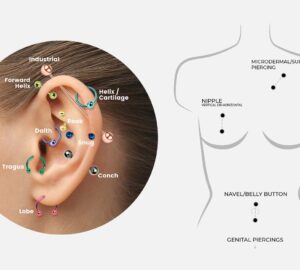Steph Simpson
Getting a new piercing can be an incredibly rewarding and exciting experience, leading to feelings of invigoration, liberation, individuality, and joy in the process. Although human beings have been piercing their bodies for literally centuries upon centuries, in the past, many of these piercings were for more traditional and cultural reasons whereas in this day and age, the main reason why we choose to pierce our bodies is so that we look good and feel good about ourselves. The problem with some body piercings however, is that people may find themselves becoming impatient and impulsive, rushing into having a new piercing without taking the time to think things through thoroughly and practically. To help ensure that when you do decide to have a new piercing, that a few weeks down the line you don’t regret the decision, you need to carefully think things through and decide exactly which piercing is right for you. To help you out and to help ensure that your heart doesn’t rule your head, or vice versa, we’ll now be taking a look at 3 ways to help you decide which piercing is right for you. So, without any further hesitation, let’s get started.
Consider how the piercing is going to look – Obviously when it comes down to body piercings, appearance is a huge factor because we obviously want to piercing to look great, otherwise we may as well not bother. However, you also need to consider the fact that it isn’t just you who will be seeing the piercing, and if you have the piercing in an especially noticeable part of your body I.E your ears, nose, eyebrow, or lip, this could potentially cause problems for you, especially at work or school for example. Before you think about getting any noticeable tattoos, take the time to first talk to your employers or your school etc, ask them their stance on piercings, and explain what you plan on getting, and where you plan on getting it. If it sounds like it’s going to be a problem and will have to be removed constantly, you may wish to rethink things as taking a new piercing out frequently can cause the body to reject it, plus it leaves you open to infections etc.
Use “fake” piercings and take pictures – If you are thinking about getting a new piercing, another very effective step you can take is to make use of “fake” piercings which are often simply clipped onto various parts of your body to help you get a better understanding of how you’re going to look with a real piercings. Say you’re thinking of a nose piercing for example, simply clip a fake nose ring where you’re thinking of having your piercing, and see how it looks. Some piercings aren’t available as clip-ons however, and in these cases you may wish to take a photograph using your smart device, and then make use of various photo editing software. Simply take a few photos of your face from different angles, open the photos in various photo editing software, and either try to draw a piercing where you plan on having it, or use an existing image of a ring or stud and see how it looks from various angles.
Consider the pain factor – Let’s face it, as cool as they look, piercings do hurt, some more noticeably than others. As gross as it sounds, when you pierce your skin you are literally making a hole in your body and ripping a hole in your skin. If you’re worried about the piercing being painful, and if perhaps you don’t have a particularly high pain threshold, you may wish to either research piercings on parts of the body that are less painful than others, or alternatively, if you had your heart set on having a certain piercing, despite it being more painful than others, you will either want to abandon the idea, or tough it out and mentally prepare yourself for the pain you’re going to experience. Obviously the most painful part of having a piercing is actually getting it done in the first place, but even so, afterwards the pieced area may be sore and sensitive for quite some time. On top of that, some piercings can be painful if you lay on them or catch them on clothing or wash cloths etc, so again, if you don’t have a very high tolerance to pain, either look for less painful piercings, tough it out, or simply abandon the idea altogether.




